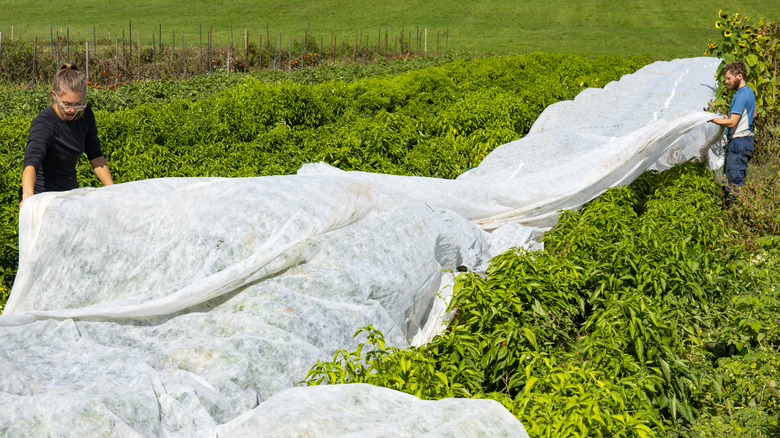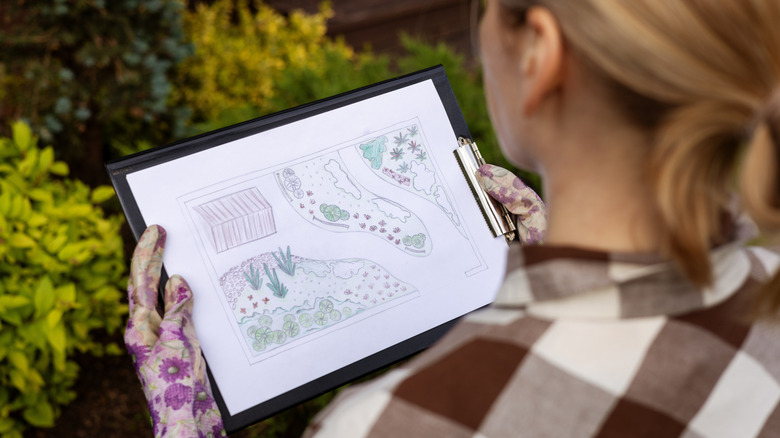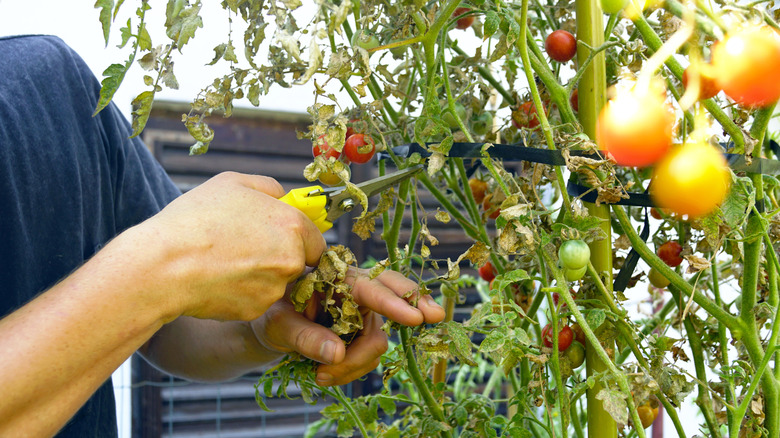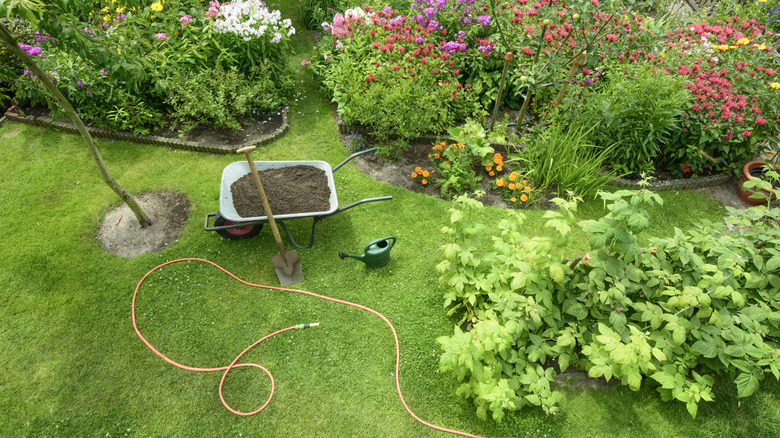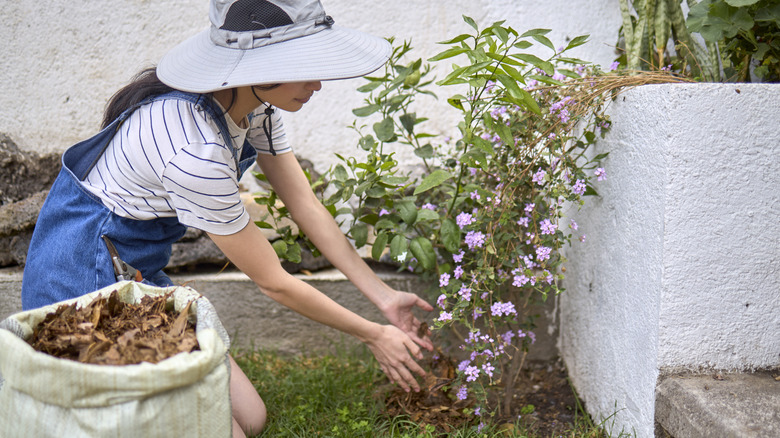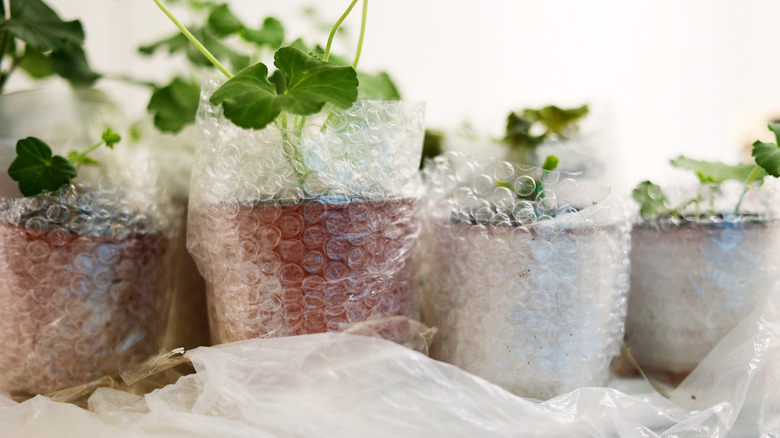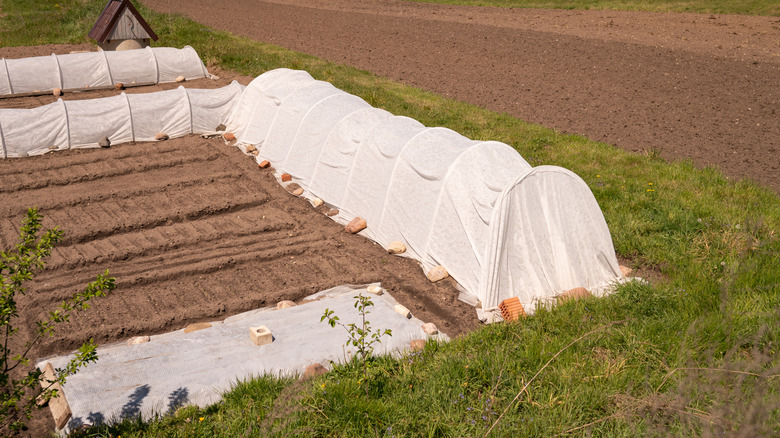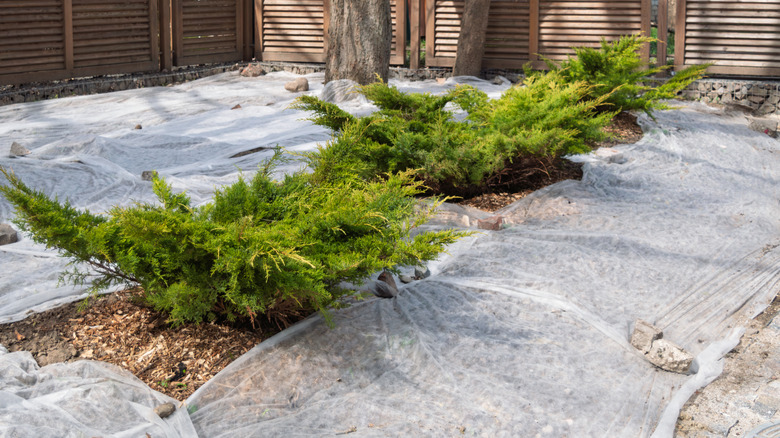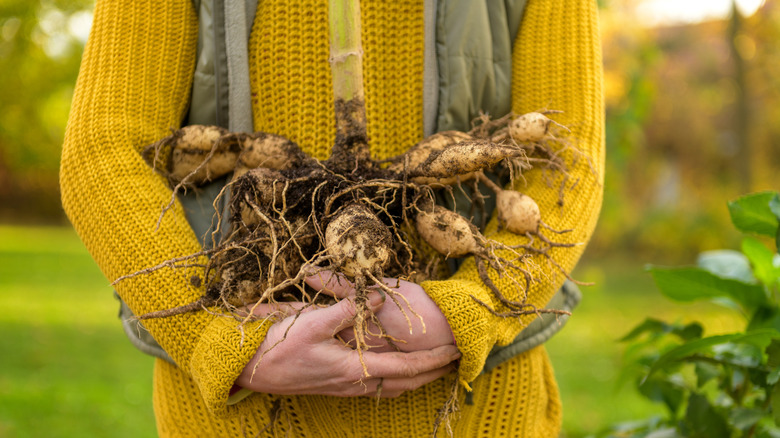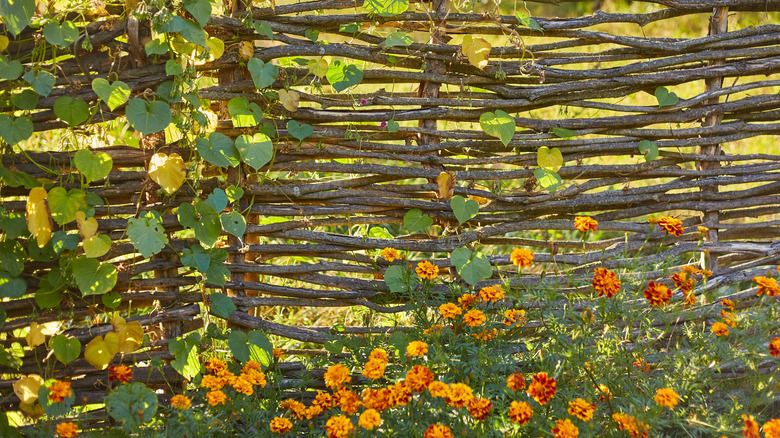How To Protect Outdoor Plants From Frost, Step By Step
We may receive a commission on purchases made from links.
If you're new to gardening, you may wonder whether frost is anything to worry about. After all, nighttime frosts often vanish by late morning. Yet even a mild frost can kill tender plants like tomatoes, squash, and flowering annuals. And with each degree the thermometer falls, more plants become endangered. That's why it's important to not only know when a frost is coming, but what you can do to protect your plants from those lower temperatures.
A combination of practices and products can aid gardeners during both predicted frost dates and random cold snaps. You may be surprised to find that unexpected items such as bubble wrap can protect plants from cold and frost. But be warned that some household materials work better than others. For example, used plastic sheeting, like old drop cloths or clear shower curtains, should be considered a last resort when frost threatens. The plastic can actually create condensation that freezes on the plants themselves. Plus, it takes careful planning to ensure you enact your measures in time and on the right plants. So, read on to find some of the best tips for protecting your plants from frost.
Surveying the garden for vulnerable plants
Well before the average frost date for your area, walk around your yard to see which plants might need various kinds of intervention. These include those you know to be less hardy, as well as younger plants and those that have recently had new growth. That survey helps you plan which plants to bring in, which to cover, and so forth. You may even find it helpful to literally map your property, making note of trees, shrubs, perennials, and newly-planted beds. Include notes of what kind of protection they'll need.
Then, gather old blankets, sheets, and other household items to protect them. You might also choose to order special frost-protecting materials, from extra mulch to cloth covers. Keep in mind how many potted plants you have outside, and where they should go. Make room in the garage or basement for the types that go dormant over the winter, or space on your windowsills for houseplants and herbs. Finally, mark the areas in which flowering bulbs are, so that they can be dug up prior to the ground getting hard in cold weather.
Strategically setting out fall plants to avoid frost
If you've still got some fall planting to do, this is your chance to plant with frost protection in mind. You might be surprised how many different "microclimates" exist on your own plot of land. A south-facing foundation planting will be very different from a shaded area at the bottom of your driveway. Keep these microclimates in mind when setting out seedlings and tender perennials. In addition, check with your local extension service to verify that the plants you want to establish are recommended for fall planting.
When you're choosing locations, avoid ones that are more likely to experience damaging conditions. For example, low-lying areas are generally the first to experience frost pockets. The bottom of a slope is a classic area in which you're likely to see frost on days in which the rest of your garden is frost-free. Shady areas also tend to be the first places frost will settle at the outset of the cold season. These tricky sites, including those under trees or the north sides of homes and outbuildings, are among the first places that frost will settle.
Checking forecasts regularly for freezing conditions
When it comes to fall garden care, obtaining a strong sense of first frost dates should be at the top of the list. First, it's helpful to know the average frost dates for your area. Your local extension service is a helpful resource for the average dates that it generally hits in your area. There are also helpful online tools available, such as those provided by The Old Farmer's Almanac.
Short-range forecasts are just as important as long-range predictions. Cold snaps can happen unexpectedly, so keeping an eye out for frost advisories is also important. By September, you should be listening to your local meteorologists with extra care. They will mention if the temperatures are expected to dip into the mid-30s, and how long that snap will last. The overnight temperatures will be the most damaging ones in most cases, allowing you to remove temporary protections during the day.
Treating damaged plants well before a frost
Plants harmed by pests and diseases are more vulnerable to frost damage. So, it's important to inspect your plants carefully for signs of insects and disease. In the fall, spider mites and aphids are among those that are likely to continue to wreak havoc in many regions. Spider mites feed on plant cells, while aphids remove life-giving sap from plants. In each case, damage to the entire plant is common, making these pests especially dangerous just before frost comes.
Blast your plants with soapy water, a strong jet from a hose, or with horticultural oil. (Just be careful not to get plant parts too wet within hours of a predicted frost.) In addition, prune badly-damaged stems and leaves. Plant diseases such as powdery mildew can also proliferate during the cooler, wetter periods of autumn. As with pest damage, diseased plants are less likely to survive frosts. Treat powdery mildew and other fungal plant diseases by removing damaged foliage, and consider a mild fungicide when appropriate.
Timing late summer and fall maintenance carefully
In general, keeping to a schedule of mid-summer pruning and early fall feeding is the best way to avoid frost damage. As summer winds down and frost dates come near, it's important to time these tasks carefully. Avoiding it altogether could be detrimental to the plant's health, yet doing it too close to frost dates can result in exposed bits or new plant growth that frost will attack.
Late summer or early fall is the last, best time for giving plants their individual nutritional needs. Feeding strengthens plants as they head for their dormant period. But avoid feeding them too close to frost dates, because it could prompt new, tender growth, making plants more vulnerable to cold damage. Likewise, trimming plants opens them up to needed water and sunlight. But do this by mid-August, so that the pruned parts have a chance to heal before the cold hits.
Watering plants before the frost
Give vulnerable plants a good watering just before frost is predicted. This action provides insulation for the plant cells themselves. That's because plant cells "plump up" when they have adequate water. Watered soil is also less apt to freeze than dry soil, because it stays warmer. One final reason? Dehydrated plants are stressed plants, meaning that they'll go into the freeze more vulnerable than healthy plants will.
The ideal time to water plants for frost protection is the morning before a projected frost. Once daytime temperatures reach about 40 degrees Fahrenheit, water garden beds and the areas around shrubs and trees. Give the soil a deep soak. It's also important to do what you can to ensure that leaves don't get overly splashed during this watering session. Foliage is more prone to damage and disease when moistened during cold weather. Holding the hose or watering can low, and keeping gardens and trees well-mulched, prevents muddy up-splash onto the plants.
Adding extra mulch to protect plants from the cold
Even if you've already mulched plants throughout the summer to keep down weeds, they appreciate extra amounts during cold snaps. Mulching around your plants not only keeps roots from freezing, but it also reduces water evaporation from chilly autumn winds. Just as importantly, mulch helps control frost "heaves." This is caused when repeated frosts and thaws push plants partially out of the soil.
To deal with frost heaving damage and other destruction, choose mulches such as straw, pine needles, or shredded leaves for vegetables, perennials, and shrubs. Heavier wood chips are ideal for larger shrubs and trees. With most garden plants, a mulch of 2 to 4 inches is helpful, but trees and shrubs need about 3 to 5 inches. Don't let the mulch touch stems or trunks; the plants can rot from contact. During the first few weeks of autumn, when the nights are chilly but the daytime is above freezing, it's helpful to rake the mulch away from the plants during the day so that the warmth of the sun can reach the soil.
Covering plants with basic household items
Repurpose old or discarded household items into helpful, no-cost frost protection tools. But make sure to pair the right material with the right plants. Save bubble wrap from your package deliveries. The sheets can be wrapped around a potted plant, container, and all, and secured with tape or clips. Putting stakes or sticks around the plant creates a framework that prevents the bubble wrap from weighing down plant stems and leaves. Bed sheets work much like the more expensive row covers that are designed to protect plants from frost. Set old cloth sheets over raised beds, and weigh each sheet down with rocks. Alternatively, wrap sheets around individual plants, secured by stakes.
Old blankets shield younger shrubs or trees that aren't quite hardy enough yet to survive frosts and freezes on their own. The blankets help retain heat from the ground. Secure the blankets at the foot of the shrubbery with stakes or heavy objects. Young seedlings need protection from cold snaps, but it doesn't have to be fancy, so you can wrap blankets around vulnerable tree trunks, too. Simple, clear plastic cups are often just the right size to set over individual seedlings, and create those precious inches of protected air between tender growth and the frosty night air. Whether it's an unexpected cold snap or you're running out of protective materials, ordinary materials such as plastic buckets and reused cardboard boxes can protect garden plants with minimal effort.
Investing in commercial frost protection products
Along with household items, commercial products offer valuable frost protection. Cloches, like Remerry's Pack of Clear Bell Covers, are bell-shaped, open-bottomed glass or heavy plastic coverings, made for protecting individual plants. By acting as mini-greenhouses, these extend the season of seedlings and other tender plants.
Although they can be a bit of an investment, row covers have various advantages over DIY coverings. They're specially designed to provide frost and pest protection, while remaining lightweight enough not to crush the plants they are draped over. For example, this Freeze Blanket from AlpineReach is designed for the colder end of the frost spectrum. "Float" them over plants, or set them over garden tunnels. Garden tunnels are ideal for protecting garden rows or beds, especially for edible plants or flowers grown for cutting. While you can make your own adjustable DIY frost cover with wire and cording, pre-made products like the LaneVan Garden Tunnel Frost Kit come with all of the supplies you need.
Finally, cold frames are an old but still-prized method of protecting seedlings and frost-tender plants. These are typically made from a bottomless box that slopes toward the front with an attached glass top that can be opened during the day to prevent overheating. Make one yourself, or order one, such as the Cold Frame from VegTrug. It's much easier to set potted seedlings in the frame or create a small bed prior to setting up the cold frame than it is to move the heavy frame around.
Removing (some) coverings during the day
During those fall weeks of frost-chilled nights and sunny days, don't assume you should leave frost protection on 24 hours a day. Plants risk getting "cooked" inside them once the temperature rises, or they can fail to get the sun and water they still need. This risk is higher with improvised protections like heavy blankets, plastic tarps, and bed sheets. Some commercial row covers and/or hoop systems, however, don't need to be removed because they are designed to let sunlight in without overheating the plants.
On sunny mornings, check outdoor thermometers to see if the air temperature has risen above freezing. Once it has, remove most coverings, especially the household items like cardboard boxes, tarps, and blankets. Doing this will allow the sun to warm up garden soil, which will be better retained at night once it's recovered. The same idea holds true for cold frames. On warmer days, prop their glass tops open to allow for better air circulation.
Bringing in potted plants when the temps drop
From dwarf trees to tropical plants and Mediterranean herbs, many outdoor plants can grow in containers. But potted plants are more susceptible to frost damage than most garden-dwelling plants are. Pots do little to protect a plant's root system during cold weather. That level of exposure leaves plants sitting in soil that's about the same temperature as the air itself when they're left outside.
Eventually, you will need to bring in potted plants permanently indoors for the winter. But for now, frosty nights don't have to signal the end of the outdoor season for your patio and porch containers. Instead, bring them inside during evenings when freezing temps are expected. In a pinch, even unheated shelters like a garage or shed provide better protection for them than exposure to the outdoor frost would. The next day, you can move your prized plants back outdoors until the next frost advisory.
Digging up tender bulbs for the winter
In cold climates, certain bulb plants need to be brought indoors in the fall, then replanted in the spring. These tender bulbs include dahlias, begonias, cannas, and elephant ears. (Because storage needs can differ, keep the care instructions when you purchase the bulbs.) Fortunately, most tender bulbs are best moved after the first frost, allowing you to protect other parts of your garden first. You'll know it's time to dig up the bulbs when their remaining foliage turns papery-dry and brown.
Use a digging fork to loosen the soil around the bulbs, gently holding the plant to partially lift it by its dry foliage. Many will need a few weeks of curing before they go into their storage buckets. Wash off cannas and dahlias, and leave them to dry indoors on a screen for a few days. Other bulbs, such as gladiolus, require up to three weeks of curing. Once they're ready, set bulbs in cardboard boxes or sturdy paper bags. Pack them with peat moss or sawdust, and place them in a cupboard or other place that doesn't go below 40 degrees F. Label your bulbs if you have more than one kind.
Establishing windbreaks for special plants
If you've already sited tender plants in front of a building or large shrub, great! Otherwise, consider establishing a simple windbreak to protect vulnerable foliage from chilly breezes during cold weather. Create temporary structures that act as a barrier from wind chill, allowing for the mini climate around the plant to remain as warm as possible. It's important to determine which way the chilliest winds are blowing. Set up your barrier so that the plants are downwind from this protective structure.
A number of low-cost methods can be used as a windbreak, including a wattle fence made by weaving together backyard branches. Several other options exist, such as chicken wire packed with leaf litter. Stacked hay bales can also work, if you have the space. Other materials include burlap, an eco-friendly material that can protect plants from frost, as well as predators like deer. (If you have the latter need, stop deer from eating evergreen shrubs by making sure the windbreak goes all the way around them). Set tall stakes in the ground and staple burlap to them.
